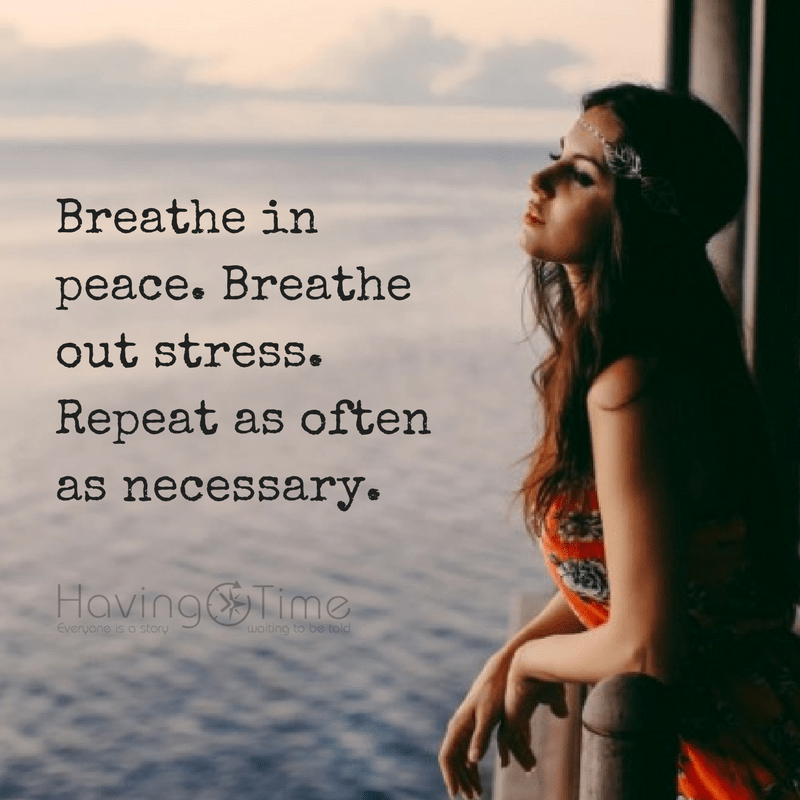From a young age, we’ve been told to whenever we get frustrated or stressed to take a deep breath and calm down. Indeed, the slow inhale and exhale helped us release tension and relieve the stress that we were experiencing at that moment. What we didn’t understand as kids, and what more researchers come to affirm, is that our breath is one of the powerful master keys into unlocking mental clarity and stillness of the mind. It is possible to breathe your way to inner calm and peace.

Most of us are unknowingly living in a chronic state of stress, and many of us don’t seem to have the necessary tools or knowledge to be able to manage it more effectively.
Chronic stress doesn’t distinguish between race, color, culture, or socio-economic status.
In fact, the World Health Organization is now considering chronic stress a “worldwide epidemic.”
Most of us are dealing with the ever-increasing demands and challenges in our lives by having another glass of wine, getting that intense workout in, finding comfort in food, or distracting ourselves with TV, friends, or shopping… the list goes on.
But what if there was another way?
What if there was another natural stress-busting solution that didn’t cost anything and would always be available to you?
Would you want to know more?
As it turns out, something, as overlooked as your own breath, can be an extremely potent tool in helping to transform chronic stress, anxiety, overwhelm, frustration, fatigue, and irritation.
In fact, it’s proven so effective that breathwork is often included as part of the training curriculum of US Navy SEALs, SWAT teams, first responders, and even snipers.
How is it that something as simple as breathing can impact our stress levels and mood?
It starts with what I call the Breath-Emotion Loop.
To better explain this concept I’ll share the following quote by yogic researcher Dr. Ananda Balayogi Bhavanani:
“Emotions and breath are known to have a deep relationship.
Animals such as the rat and rabbit have fast breathing and so are extremely nervous, mentally unstable, emotionally restless, and live only for short period of time.
In contrast, the elephant and turtle are slow, deep breathers and consequently have calmer personality and longer lives.”

Emotions and breathing rhythms have a two-way, symbiotic relationship because they both impact one another.
Breathing rhythms (aka the way you breathe) can be fast or slow, shallow or deep, short or long.
Breathing rhythms send messages to your body that affect your mood, your stress levels, and even your immunity.
The way you breathe can change your emotional and mental state
If you breathe fast and shallow, your brain’s arousal center becomes hyperactivated. This can lead to increased alertness, wakefulness, excitement, or anxiousness.
If you breathe slow, deep, and long, you’ll become calmer because the arousal part of your brain isn’t being activated.
Heightened emotional states influence the body’s breathing mechanism.
Feeling angry, anxious, excited, tense, or scared translates to short and shallow breathing.
Feeling relaxed, serene, or content translates to longer, slower, deeper breaths.
Our breath automatically responds to our emotional shifts. That is until we consciously control it.
Emotions cause changes in the body, and breathing is one of the bodily processes most impacted by emotions.
How can we consciously use our breath to begin dissolving stress and increasing a sense of inner calm?
Let’s practice a simple yet effective breathing technique called Tactical Breathing (aka Combat breathing.)
This is the same breath training used by US Navy SEALs as mentioned before, so if it works for them it is very likely to work for you!
HOW TO:
1. Sit comfortably and upright.
2. For each inhale and exhale remember to breathe through your nose and keep your mouth closed.
3. With each inhale be sure to expand the lower belly outwardly as your lungs fill with air. With each exhale be sure to contract your lower belly inwardly as your lungs empty of air. (By doing this you’re further activating your body’s natural relaxation response.)
4. Inhale for 4 counts
5. Hold for 4 counts
6. Exhale for 4 counts
7. Hold for 4 counts
8. Repeat steps 4-8 for 19 cycles (5 minutes)
In conclusion
“Mindfully changing your breathing patterns appears to send a signal to the brain to adjust the parasympathetic branch of the nervous system, which can slow heart rate and digestion and promote feelings of calm as well as the sympathetic system, which controls the release of stress hormones like cortisol.
Controlled breathing has been shown to reduce stress, increase alertness and boost your immune system. For centuries yogis have used breath control, or pranayama, to promote concentration and improve vitality. Buddha advocated breath-meditation as a way to reach enlightenment.
Science is just beginning to provide evidence that the benefits of this ancient practice are real. Studies have found, for example, that breathing practices can help reduce symptoms associated with anxiety, insomnia, post-traumatic stress disorder, depression and attention deficit disorder.
“Breathing is massively practical,” says Belisa Vranich, a psychologist and author of the book “Breathe,” “It’s meditation for people who can’t meditate.”

